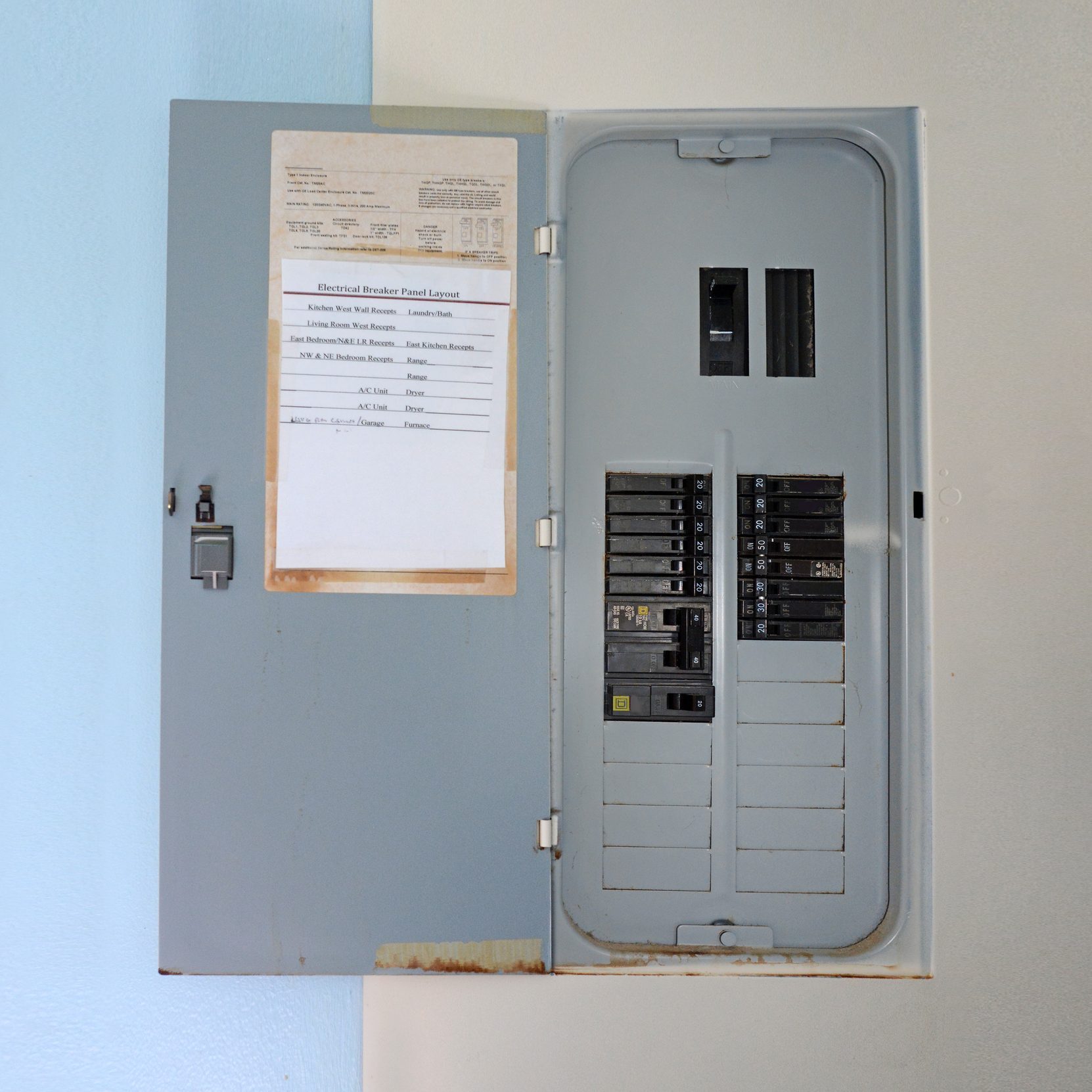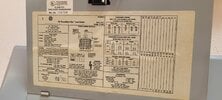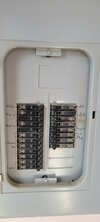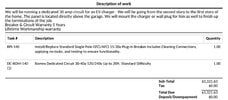I just bought Model 3 (standard range/RWD). Also I bought mobile connector. I am planning to install 240V outlet in garage for the mobile charger. I am in condo with max rated Amp is 125 Amp. I have two empty slots available in circuit breaker panel. Should I instruct electrician to install 30 or 40 amp circuit breaker? If he install only 30 amp circuit breaker, my assumption is mobile charger will not draw more than 30 amp, though the mobile connector can draw 32 amp. If only 30 amp circuit breaker installed, how much miles I will charge per hour?
Welcome to Tesla Motors Club
Discuss Tesla's Model S, Model 3, Model X, Model Y, Cybertruck, Roadster and More.
Register
Install the app
How to install the app on iOS
You can install our site as a web app on your iOS device by utilizing the Add to Home Screen feature in Safari. Please see this thread for more details on this.
Note: This feature may not be available in some browsers.
-
Want to remove ads? Register an account and login to see fewer ads, and become a Supporting Member to remove almost all ads.
You are using an out of date browser. It may not display this or other websites correctly.
You should upgrade or use an alternative browser.
You should upgrade or use an alternative browser.
Guidelines to electrician
- Thread starter mncbabu
- Start date
spsheridan
Member
A 30A breaker will provide 24A of continuous power while a 40A breaker will give you 32A (both 80% of the breaker rating). You’ll get about 21 miles per hour of charge with the former and about 28 miles per hour of charge with the latter.
brkaus
Well-Known Member
It’s really more up to your electrician on how large a circuit can get added. They should do a load calculation after reviewing your property and it’s electrical appliances.
If you are using the mobile connector, the electrician will install an outlet and you will need to purchase the matching adapter.
The adapter will set the max safe amount if current the car can pull (up to 32a on an 40a/50a outlet).
If you are using the mobile connector, the electrician will install an outlet and you will need to purchase the matching adapter.
The adapter will set the max safe amount if current the car can pull (up to 32a on an 40a/50a outlet).
Can you give us a picture of your electrical panel showing the breakers? That'll give us a rough idea of how much capacity you have.I just bought Model 3 (standard range/RWD). Also I bought mobile connector. I am planning to install 240V outlet in garage for the mobile charger. I am in condo with max rated Amp is 125 Amp. I have two empty slots available in circuit breaker panel. Should I instruct electrician to install 30 or 40 amp circuit breaker? If he install only 30 amp circuit breaker, my assumption is mobile charger will not draw more than 30 amp, though the mobile connector can draw 32 amp. If only 30 amp circuit breaker installed, how much miles I will charge per hour?
If you install a 30A breaker, the electrician will install a NEMA 14-30 receptacle, you'll have to buy the 14-30 adapter from Tesla, and the Mobile Connector will allow you to charge at 24A. If you install a 40A receptacle, the electrician will install a NEMA 14-50 receptacle, you'd buy a 14-50 adapter from Tesla and the Mobile Connector will allow you to charge at 32A.
Frankly. I'd just ask for a 30A breaker/receptacle (assuming your panel doesn't look too overloaded right now).
Also make sure it’s a commercial / quality receptacle as wiil be in continuous use. If you’re paying an electrician anyway, you might consider the Tesla Wall Connector which eliminates the outlet point of failure and then you can keep the mobile adapter in the car. The latest TWC can charge Tesla and non Tesla’s so future proofed. Note that just because it says it can do up to 48A (on a 60 amp circuit), you can set it up to be less than that if you only have a 30A or even a 15 amp breaker.
Yes, I agree. I forgot to mention that when you install a new receptacle for EV charging, it has to have a GFCI breaker, at least by code. Of course, it’ll work without one. I didn’t mention it because the OP said they had already bought the Mobile Connector.Also make sure it’s a commercial / quality receptacle as wiil be in continuous use. If you’re paying an electrician anyway, you might consider the Tesla Wall Connector which eliminates the outlet point of failure and then you can keep the mobile adapter in the car. The latest TWC can charge Tesla and non Tesla’s so future proofed. Note that just because it says it can do up to 48A (on a 60 amp circuit), you can set it up to be less than that if you only have a 30A or even a 15 amp breaker.
RayK
Active Member
Since you already have an SR and the mobile connector...I just bought Model 3 (standard range/RWD). Also I bought mobile connector. I am planning to install 240V outlet in garage for the mobile charger. I am in condo with max rated Amp is 125 Amp. I have two empty slots available in circuit breaker panel. Should I instruct electrician to install 30 or 40 amp circuit breaker? If he install only 30 amp circuit breaker, my assumption is mobile charger will not draw more than 30 amp, though the mobile connector can draw 32 amp. If only 30 amp circuit breaker installed, how much miles I will charge per hour?
- a 30A breaker will yield 24A of charging power going into your car as long as you use a NEMA 6-30, or 10-30, or 14-30 adapter with the mobile connector
- as far as I know, there's no such thing as a NEMA power outlet which is designated as 40A, even though there are 40A breakers
- a 50A breaker will allow a maximum of 40A of power, however.....
- the mobile connector can only provide 32A AND your car is limited to 32A (due to having only two 16A charger modules), therefore....
- don't be fooled into thinking that you're going to get any more than 32A
- the difference in miles per hour for 24A versus 32A is about 8MPH; 24A --> 22MPH, 32A --> 30MPH as outlined in the 10-30 or 14-30 Tesla NEMA adapter l linked above
- the cost differential between installing a circuit capable of supporting a 30A breaker vs. 50A can be substantial (if it's a long run between the panel and outlet); ask your electrician what it is and decide if it's worth it to you to spend the extra money for 8MPH
- also ask your electrician to do a load analysis on your electrical equipment needs; it may only be possible to add 20A given what you have
- if your normal recharging requirements only needs to support adding less than 150 miles overnight, then a 30A circuit is all you really need
Last edited:
Thank you all for the excellent information. A 30A breaker will provide 24A of continuous power while a 40A breaker will give 32A (both 80% of the breaker rating). I’ll get about 21 miles per hour of charge with the former and about 28 miles per hour of charge with the latter. I travel 60 miles round trip to work during week days. Therefore, I prefer to have 40A breaker to maximize the charging capability (of the battery in model 3 and mobile charger), if feasible. I have attached the picture of the circuit breakers panel. I have currently three 30A heavy duty appliances (AC, Oven and Dryer). We do not use oven much; also it is gas range. We will be charging the EV primarily during midnight to 6 am. With this information, Can I instruct the electrician to install 40A breaker with NEMA 14-50 outlet?Can you give us a picture of your electrical panel showing the breakers? That'll give us a rough idea of how much capacity you have.
If you install a 30A breaker, the electrician will install a NEMA 14-30 receptacle, you'll have to buy the 14-30 adapter from Tesla, and the Mobile Connector will allow you to charge at 24A. If you install a 40A receptacle, the electrician will install a NEMA 14-50 receptacle, you'd buy a 14-50 adapter from Tesla and the Mobile Connector will allow you to charge at 32A.
Frankly. I'd just ask for a 30A breaker/receptacle (assuming your panel doesn't look too overloaded right now).
Attachments
brkaus
Well-Known Member
Not sure why you use the words “instruct” when talking about the electrician. Hopefully they should be educated enough that you ask them what you prefer and they tell you if it’s possible or other options.
I am trying to understand if 40A circuit breaker is feasible. I could not reach the electrician who estimated the workNot sure why you use the words “instruct” when talking about the electrician. Hopefully they should be educated enough that you ask them what you prefer and they tell you if it’s possible or other options.
Attachments
That's a lot of circuits for a 125 amp electric service. Make sure that the electrician does a proper load calculation per the National Electric Code to determine how much capacity is available on your service/panel. This is done by factoring in the size of the residence in square feet, and also tallying up the size of certain breakers you already have. Some of the breakers are de-rated for the calculation and some are counted at full value. The results of this load calculation will tell you what size breaker for EV charging your existing panel can handle (assuming you have some excess capacity)...
Here's a short article that goes over the big picture of performing a load calculation (any good electrician will know how to do this):

 www.familyhandyman.com
www.familyhandyman.com
Here's a short article that goes over the big picture of performing a load calculation (any good electrician will know how to do this):

A Guide to Electrical Load Calculation
If you're planning to increase your electrical load by adding a new major appliance, you better make sure your panel has the capacity to handle it.
I see you are in San Diego. A permit from the City is required for EV charging; here is more information about that...
The load calculation I mentioned above will be needed to submit to the City for the permit...
The load calculation I mentioned above will be needed to submit to the City for the permit...
RayK
Active Member
I would not put a 50A outlet (NEMA 14-50) on a 40A breaker. Maybe that's to code but if I were doing it, I'd either go full out - 50A breaker and 50A outlet, or downgrade everything to 30A. Or course this assumes that a load analysis says you can go that high.
If you do go with a 40A breaker with the 14-50 outlet, be sure to LABEL the outlet accordingly (i.e., "maximum continuous amperage is 32A"). You might know this but if/when you sell your place and the next guy comes along and sees, "Hey! There's already a 50A outlet here!", there might be problems.
If you do go with a 40A breaker with the 14-50 outlet, be sure to LABEL the outlet accordingly (i.e., "maximum continuous amperage is 32A"). You might know this but if/when you sell your place and the next guy comes along and sees, "Hey! There's already a 50A outlet here!", there might be problems.
Notwithstanding RandyS, I wouldn’t have a problem with adding a 32A load to that panel. The only big load running at night is the AC. Of course, it could get dicey if you tried to charge during the day with the dryer running, but even then, looks like you have headroom.
Yes, it is to code to install a Nema 14-50 50A outlet on a 40A breaker. I do agree that to be on the safe side, I’d label the outlet as having only a 40A breaker in case the next house occupant decides to plug in a different EVSE.
Yes, it is to code to install a Nema 14-50 50A outlet on a 40A breaker. I do agree that to be on the safe side, I’d label the outlet as having only a 40A breaker in case the next house occupant decides to plug in a different EVSE.
He says he’s in a condo, so maybe the main breakers are all together near their respective meters somewhere inaccessible.Where is your main breaker? The photo is a sub-panel.
brkaus
Well-Known Member
Has to be accessible somewhere, I would think.He says he’s in a condo, so maybe the main breakers are all together near their respective meters somewhere inaccessible.
125a subpanel label means nothing
ucmndd
Well-Known Member
If you insist on “instructing” the professional you’re paying to do this work safely and to code, instruct them that you would like the highest amperage outlet your panel and load calculation can support.
That said, ANY 240v outlet will have zero issues replenishing 60 miles of range overnight.
That said, ANY 240v outlet will have zero issues replenishing 60 miles of range overnight.
RayK
Active Member
A 30A circuit (breaker and NEMA outlet) yields about 22 miles per hour charge rate. Even if it's 20MPH, due to voltage drops and what have you, you will only need 3 hours of charging overnight to get back those 60 miles you used the previous day. Even if you skip charging for a day, or drove around town doing some errands, say another 60 miles, for a total of 120 miles, you will still only need 6 hours to regain 120 miles. At SDGE off-peak hours (12m to 6a), you could still do it.`<snip> I travel 60 miles round trip to work during week days. Therefore, I prefer to have 40A breaker to maximize the charging capability (of the battery in model 3 and mobile charger), if feasible. <snip>
I understand the desire to get the most "bang for your buck". If I were still working, and didn't have charging at work, and didn't have access to a cheaper source of electrons than what I could get at home, I too may want the biggest circuit my panel could support.
Gauss Guzzler
Safety Score = 42
With only 20' of wire it would be ridiculous to skimp on a 30-40A circuit. Just run 6/3 Romex on a 50A breaker to a 14-50 outlet. It'll be safer, more efficient, and upgradeable to 40A charging with a wall-mounted charger. Ignore the "load calculation" worry-warts. If your lights dim more than you'd like when charging at full power with the AC and oven running, then just don't charge at full power when the AC and oven are running.
20' of 6/3 NM-B (a.k.a. 50A Romex) will cost $75 at full retail.
20' of 10/3 NM-B (a.k.a. 30A Romex) will cost $30 at full retail.
So, you're wise to ask here because any electrician should have told you that a 50A circuit is the only way to go since you'd only save $35 with a half-ass variant.
20' of 6/3 NM-B (a.k.a. 50A Romex) will cost $75 at full retail.
20' of 10/3 NM-B (a.k.a. 30A Romex) will cost $30 at full retail.
So, you're wise to ask here because any electrician should have told you that a 50A circuit is the only way to go since you'd only save $35 with a half-ass variant.
Similar threads
- Question
- Replies
- 16
- Views
- 1K
- Replies
- 12
- Views
- 408
- Replies
- 19
- Views
- 567
- Replies
- 82
- Views
- 3K
- Replies
- 11
- Views
- 2K





